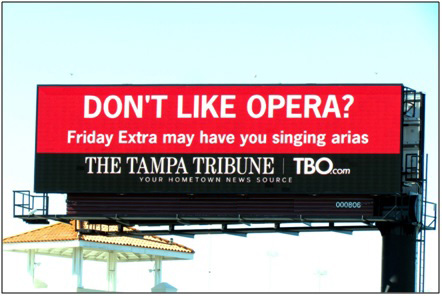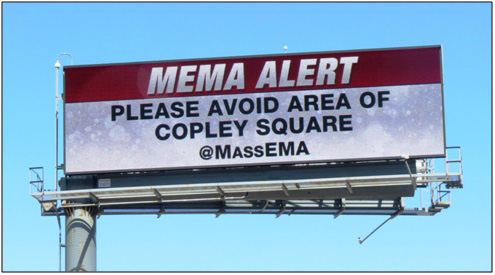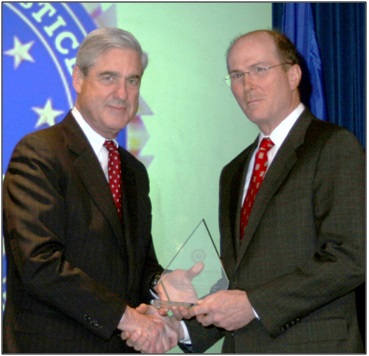Digital Issue Brief
Message Points
- Digital billboards serve businesses and communities by communicating information that can be quickly changed
- Digital billboards are accepted by government and the public
- Digital billboards are regulated by government and self-regulation by the industry
- Digital billboards are not distracting to drivers, according to government research
- Government relies of digital billboards on behalf of public safety
- Digital billboards support jobs
Government-sponsored anti-distraction message on digital billboard in Connecticut
Digital Billboards
High-tech communication for advertisers and communities
Digital technology is a non-manual way to change billboard “copy,” via computer. Digital billboards do not flash or scroll; they display static images that rotate typically every six or eight seconds.
Advertisers can change their messages quickly, without the time and expense of printing or posting. Other media are major buyers of digital billboards, featuring news, sports, weather, programming, and personalities.
Likewise, communities use digital billboards to deliver information to the public.
Other media are major buyers of digital billboards
Digital billboards are accepted/regulated
“Digital billboards are right in line with the whole cityscape. They communicate that we are a city that embraces technology. We actually have some of the newest state-of-the art cutting edge advertising,” said Joe Cimperman, a long-time city councilman in Cleveland, OH.
Keeping pace with technology, government has regulated and authorized digital billboards. The federal government says states can allow digital billboards as long as they do not flash, scroll, or feature full motion. Nearly all states with billboards allow digital billboards, which operate in nearly 1,000 communities.
Anti-billboard Scenic America attacked the federal guidelines in court; in 2014 a federal judge dismissed the case, with prejudice.
Industry practices conform to federal guidance, such as display times and lighting. Federal guidelines, issued in 2007, say digital billboards should “adjust brightness in response to changes in light levels so that the signs are not unreasonably bright for the safety of the motoring public.” Digital billboards are equipped with light sensors that adjust brightness to surrounding light conditions, to avoid glare.
The out of home advertising industry has established standards that lighting levels should not exceed 0.3 foot candles above the level of surrounding light conditions. State and local governments have incorporated this standard into regulations.
The OAAA Code of Industry Principles commits to providing effective and safe digital billboards:
- We are committed to ensuring that the commercial and noncommercial messages disseminated on standard-size digital billboards will be static messages and the content shall not include animated, flashing, scrolling, intermittent or full-motion video elements (outside established entertainment areas).
- We are committed to ensuring that the ambient light conditions associated with standard-size digital billboards are monitored by a light sensing device at all times and that display brightness will be appropriately adjusted as ambient light levels change.
The respected media research firm Arbitron has studied public opinion (Los Angeles County, 2009, and the metro area of Cleveland, OH, 2008). With similar findings in each study, Arbitron says most commuters feel that digital billboards are a cool way to advertise and also provide important community information.
Traffic Safety
On December 30, 2013, the Federal Highway Administration (FHWA) released the findings of its multi-year research on drivers’ behavior in proximity to digital billboards.
“DOT study finds digital billboards don’t distract drivers,” said the headline in The Hill newspaper in Washington, DC (January 7, 2014).
The government’s findings tracked the outcome of industry-sponsored research, which found no connections to accidents.
FHWA’s sister agency the National Highway Traffic Safety Administration (NHTSA) said in 2006: “Short, brief glances away from the forward roadway for the purpose of scanning the driving environment are safe and actually decrease near-crash/crash risk.”
This 2006 NHTSA study (“100-Car Naturalistic Driving Study”) said glances totaling more than 2 seconds increase crash risk. FHWA’s later research on digital billboards, released December 30, 2013, said the longest glances toward digital billboards were less than 1.3 seconds.
State review of crash data
Meanwhile, states have reviewed crash data. Effective January 1, 2015, New York State switched from 24-hour to 8-second display time on digital billboards. New York’s analysis of crash data “suggests there is no change in the crash patterns in the vicinity of the off-premise CEVMS billboards,” and continued monitoring is warranted.
Massachusetts DOT also looked at crash data: “The traffic engineers preparing the reports found no detrimental safety impacts” of the digital billboards.
A media report in 2015 summarized state regulatory acceptance of digital billboards, including New York State and Massachusetts.
Digital billboards help public safety
Emergency message after the Boston Marathon bombing
Government relies on digital billboards to communicate with the public.
Since 2008, the National Center for Missing & Exploited Children has transmitted more than 1,000 AMBER Alerts to digital billboards. The Center points out that time is of the essence after child abductions, and, therefore, quick posting on digital billboards is an important part of the AMBER Alert network.
The FBI says it has apprehended 53 fugitives as a direct result of tips from the public prompted by information on digital billboards.
The FBI calls digital billboards a “force multiplier.” On March 16, 2012, FBI Director Robert S. Mueller presented the Director’s Community Leadership Award to Ken Klein of the Outdoor Advertising Association of America in recognition of the industry’s partnership to help law enforcement via digital billboards.
FBI Director Robert S. Mueller presents award to Ken Klein (OAAA)
At the local level, Albuquerque, NM, used digital billboards to urge conservation during a winter-time natural gas shortage. Police in Janesville, WI, post a variety of messages. “An elderly female suffering from Alzheimer’s disease wandered away from family in a local shopping mall and was found by a citizen using the digital billboard information. When spring floods along the Rock River posed significant danger to the public, billboards were used to post warnings about the danger,” wrote Chief of Police Neil Mahan (retired) in The Police Chief magazine.
FEMA message on digital billboard after storms hit Tuscaloosa, AL
Digital billboards support jobs
Billboard advertising supports jobs in local communities, typically more than two dozen jobs per advertiser. The digital sign industry also supports thousands of manufacturing jobs, incubates new ideas, and produces exports.
In 2001, Time-O-Matic, known for time-and-temperature signs, added Watchfire to its name to represent new products such as LED signs. “Watchfire is a living, thriving example for communities across America” that small business development is an engine of the overall economy, says Vicki Haugen of the economic development arm of Danville, IL, and surrounding Vermillion County.
U.S. Senator John Thune, R-SD, echoes that point. “Daktronics is the type of company that communities dream of having,” said Thune, calling the company an “integral” part of the community of Brookings, SD. Daktronics designs and builds digital displays, electronic scoreboards, and programmable display systems. Each day in nearly 100 countries, millions of people depend on displays and scoring systems made by Daktronics, which is competing globally from small-town America.
In 1920, an immigrant from England named Tom Young went into the sign business with $300. Today, Young Electric Sign Company – based in Salt Lake City, UT — manufactures on-premise and off-premise signs including high-tech LED boards in Logan, UT.
References
“Built in the USA: Growing Outdoor at Home,” Ken Klein, Outdoor Advertising Magazine, January/February 2009
“Digital Advertising Board — Pilot Program,” Bonnie Polin, Chief Safety Analyst, Massachusetts Department of Transportation, November 22, 2011
“Digital Billboards and Law Enforcement Agencies: A New, High-Tech Partnership,” Neil Mahan, chief of police (retired), Janesville, WI, The Police Chief magazine, March 2009
“Digital Billboard Initiative: Catching Fugitives in the Information Age,” Federal Bureau of Investigation, posted online December 24, 2014
“Driving Performance and Digital Billboards,” Virginia Tech Transportation Institute, Center for Automotive Safety Research, March 22, 2007
“DOT study finds digital billboards don’t distract drivers,” The Hill, 1625 K Street, NW, Washington, DC 20006, January 7, 2014
“Guidance on Off-premise Changeable Message Signs,” Federal Highway Administration memorandum, Gloria M. Shepherd, Associate Administrator for Planning, Environment, and Realty, September 25, 2007
“The Effects of Commercial Electronic Variable Message Signs (CEVMS) on Driver Attention and Distraction: An Update,” John A. Molino, Jerry Wachtel, John E. Farbry, Megan B. Hermosillo, Thomas Granda; Publication No. FHWA-FHT-09-018, Federal Highway Administration, February 2009




